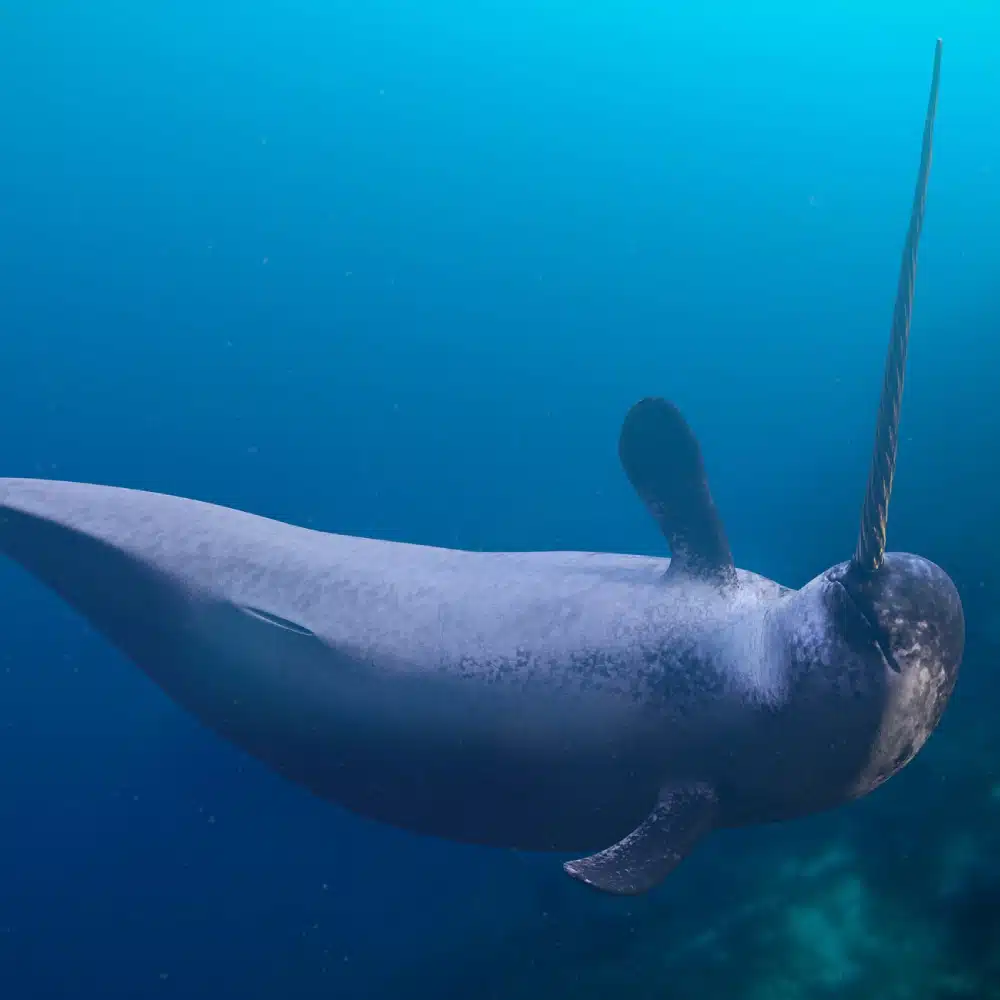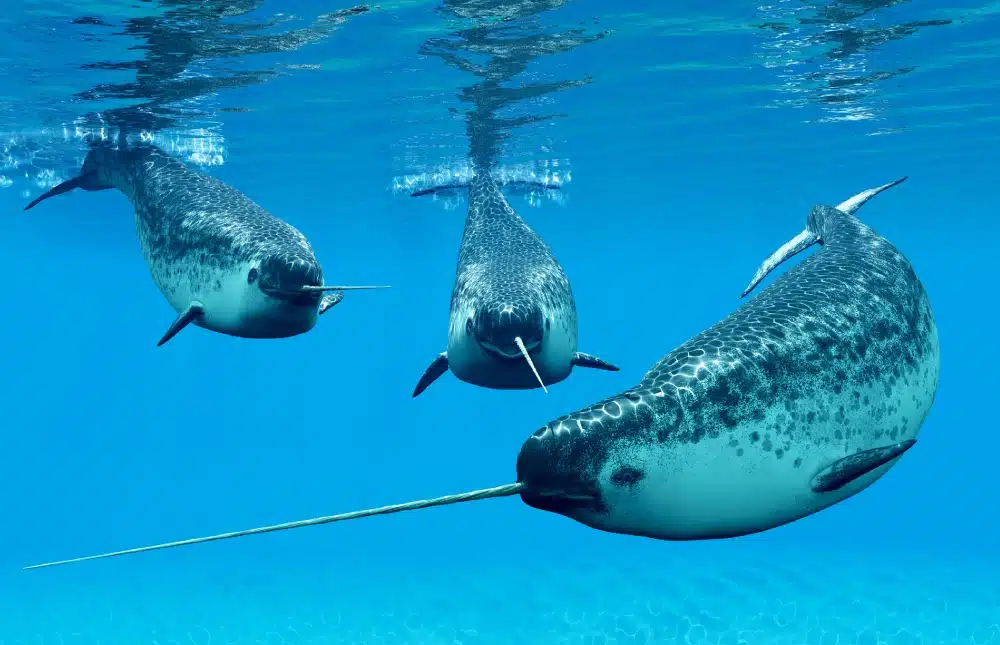The mysterious unicorn of the seas
The twisted horn of this iconic Arctic creature, which is actually a tusk , has earned it the nickname of ‘the unicorn of the seas’. Both hunted and revered, the narwhal continues to fascinate. Although this mysterious cetacean is rare and discreet, it still canvasses its favourite hunting grounds around the coasts of Greenland and Canada. Polar explorer and Greenland specialist Nicolas Dubreuil invites us to discover this secret world.
The narwhal, the unicorn of the Arctic
The word ‘narwhal’ is imbued with connotations from an icy world. For Nicolas Dubreuil, it resonates with adventure and extends an invitation to pursue a ghost, a fleeting apparition on the edge of the world. This quest – which is as much about fulfilling a childhood dream as completing an expedition – gives the animal such an extraordinary aura that it has even shaped the names people have given it.
Its etymology is a journey in itself. The name ‘narwhal’ derives from the Old Norse nár (‘corpse’), in reference to its colour which recalls that of a drowned body. Its scientific name, Monodon monoceros, means ‘one tooth, one horn’. But the Inuit vision goes deeper: their word qilalugaq refers to both the narwhal and its cousin the beluga. For them, this family’s unity was evident long before scientific classifications existed.

Polar explorer Nicolas Dubreuil

Diver of the abyss
The narwhal is a cetacean that is perfectly adapted to icy waters. Its streamlined body can reach five metres long, and its grey mottled skin gives it an ideal camouflage! Above all, the narwhal is an extraordinary diver who can descend to depths of more than 1,800 metres to feed on squid and shrimp, halibut and polar cod. At such depths, the pressure is extreme and the darkness absolute. This condition is essential for its survival during the winter, when the pack ice covers its world.
Long-in-the-tooth myths
Many legends have wound their way around the narwhal’s spiralling tusk. In the West, it has long been associated with the myth of the unicorn. From the Middle Ages onwards, the narwhal’s tusk was sold at premium prices for its supposedly magical virtues. But for the Inuit, these stories are not distant fables but the lifeblood of their culture, handed down from generation to generation.
“The narwhal is highly present in the Inuit imagination from childhood,” explains Nicolas Dubreuil. “From an early age, children are fed stories and legends about the narwhal by their parents” like that of Sedna, the Inuit goddess of the sea. In one of the Inuit’s creation myths, a young girl was thrown into icy waters, but her long braided hair coiled up to form the narwhal’s famous twisted tusk, forever linking the animal to polar cosmogony.

Master hunters
While the narwhal is imbued with a dreamlike quality in the West, it is a vital reality for the Inuit and a pillar of their survival and culture. “Narwhals are opportunity hunts,” explains Nicolas Dubreuil. “When they pass in front of the small village of Kullorsuaq,” (editor’s note: where the explorer lives for part of the year), “the village goes into a frenzy. It leaves quite an impression.”
But as soon as they’re on the water, their effervescence gives way to absolute concentration: on their boats or occasionally kayaks, even the smallest sound is forbidden. The approach is determined by the animal’s breaths and the harpooner’s movements are meticulous. “The technique is incredibly precise.” Once the catch is secured, the Inuit share the prize in a social act that unites the community around a ritual permeated with absolute respect.

Polar explorer Nicolas Dubreuil

The sharing ritual
The way in which the animal is distributed among the community is a highly codified ancestral ritual, as Nicolas Dubreuil explains: “The head and tusk are given to the person who first spotted the narwhal, the left flipper to the person who shot it, the tail to the second harpooner, and so on.” But within this hierarchy, “there’s always a part that’s reserved for the village, for those who couldn’t make the hunt. Finally, they leave some of the carcass for the bears and foxes… It says a lot about their vision of the world. It’s incredible!”
Know-how vs. science
The Inuit’s absolute respect for the narwhal is based on their detailed knowledge of the animal, right down to its most secret behaviours. This empirical knowledge is capable of competing with the most advanced technologies. Where researchers deploy beacons to collect data, Inuit hunters read the weather, the ice and the wind to pinpoint their own certainties.
So when Nicolas Dubreuil asked hunters where to find narwhals, their answer was astonishing: “It depends. When? What time?” The same applies to the use of the tusk: “They were the ones who explained to me that they were used to pierce halibut or stun fish back when scientists were still coming up with cautious hypotheses. What a lesson that was!”

Polar explorer Nicolas Dubreuil

Listen to the song of the narwhal
To build a bridge between these two worlds, Nicolas Dubreuil launched an idea with bioacoustician Olivier Adam. We have, on the one hand, Inuit knowledge: by plunging a simple paddle into the water and sticking the handle to their jawbone, a hunter can transform his body into a hydrophone that enables him to locate the animal with incredible precision. On the other hand, we have cutting-edge science: laboratory studies of how sound is propagated through the tusk. The idea is to bring together Olivier Adam’s modelling with the ingenuity of the hunters by taking these discoveries to Greenland so that new insights might emerge from this combination.
The secret routes of the narwhal
“Every observation is an opportunity,” says Nicolas Dubreuil. The narwhal is a fearful and nomadic animal that undertakes an unchanging journey. Every year, when the ice melts, it uses the channels that wind through the pack ice to reach its sanctuaries in Baffin Bay: Melville Bay and the Qaanaaq region. In this fragile world, targeted efforts are still required to preserve this ‘near threatened’ species, which is particularly sensitive to the effects of climate change and the impact of human activities.
And what if, in the end, this privilege was less about the destination and more about a different way of existing in the world? That is the lesson of the Inuit: observe, wait and feel, until you become one with an environment from which they never dissociate themselves. “For them, the word ‘nature’ doesn’t exist,” explains the explorer. Seeing the world through their eyes is the key to preserving the narwhal and the culture that is so closely linked to it.

Polar explorer Nicolas Dubreuil
Photos credits: ©PONANT/Julien Fabro; ©iStock

Set sail for the Arctic



